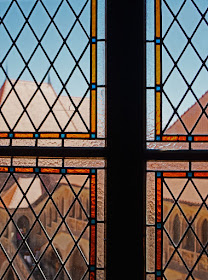The Városliget in Budapest
harbours the rather intriguing architectural specimen of the Vajdahunyad
castle, an end of the 19th Century fever dream combining elements of
disparate historical buildings from diverse Hungarian inhabited lands. While it’s not all bad in its entirety, it
has always given me too much of a Frankenstein feeling to feel completely at peace
with it, and my spring wandering through the taxidermy of the Agricultural
Museum has done nothing to ease the tension.
I of course always knew that the
basic model is the ‘real’ castle in Hunedoara, and that Hunedoara is pretty
close to my hometown, but as it often happens, you long to travel to faraway
lands and miss out on what’s right in front of you, so to speak. Hunedoara
itself does get bad press for having been a communist monstrosity of mines and
factories, and to be frank, it still is pretty dull and a bit too socialist
brutal for most tastes.
The castle is of course, as a Brit
would remark, pretty. It feels very much
like a castle-ish castle- there are parts from different periods, the newer
ones obviously shinier and better preserved, yet it’s the older stone fortress
part that gives a sense of real history. It’s also the place where you can
escape the tourist infestation, for as a younger visitor exclaimed, it’s just a
room!- and then he was promptly off.
‘Just a room’ happened to be the place where the positions of the canons were
still clearly visible and you could discern how they were adapted to the
landscape, aiming at the nooks and crannies where an evil Turk might try to sneak in. And ‘just a room’ also happened to be called
the Nebojša tower, from the Serbian ‘do not be afraid’, a reminder of both
Iancu de Hunedoara’s famous battle of Belgrade and the fact that ethnic groups
were so intensively intermingling in this part of the world that it’s outright
silly to have hissy fits over whom a particular mountain or valley belongs to.
Today they belong to anyone who happens to live there and anyone who visits
them with an open mind and heart.






















No comments:
Post a Comment